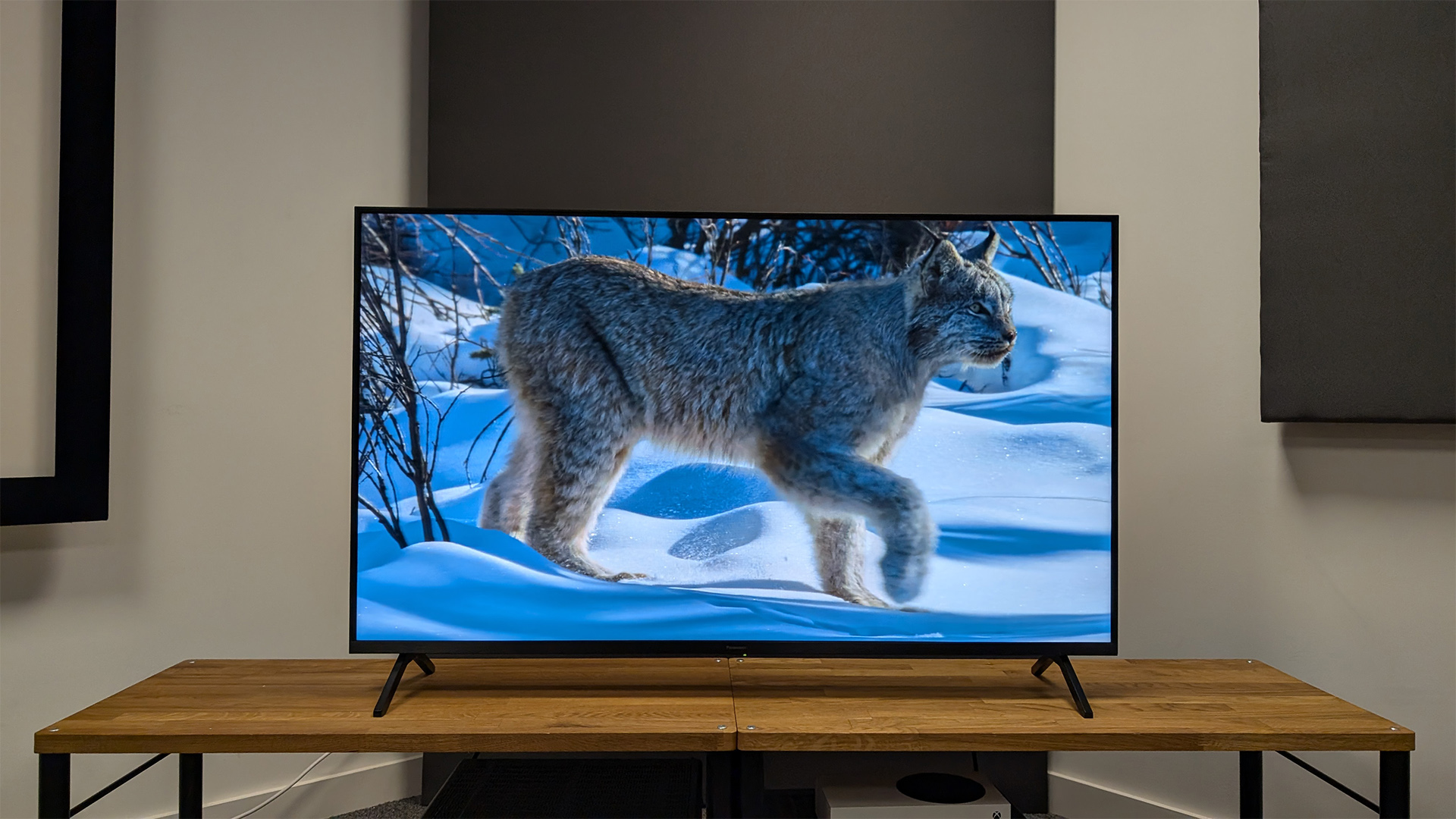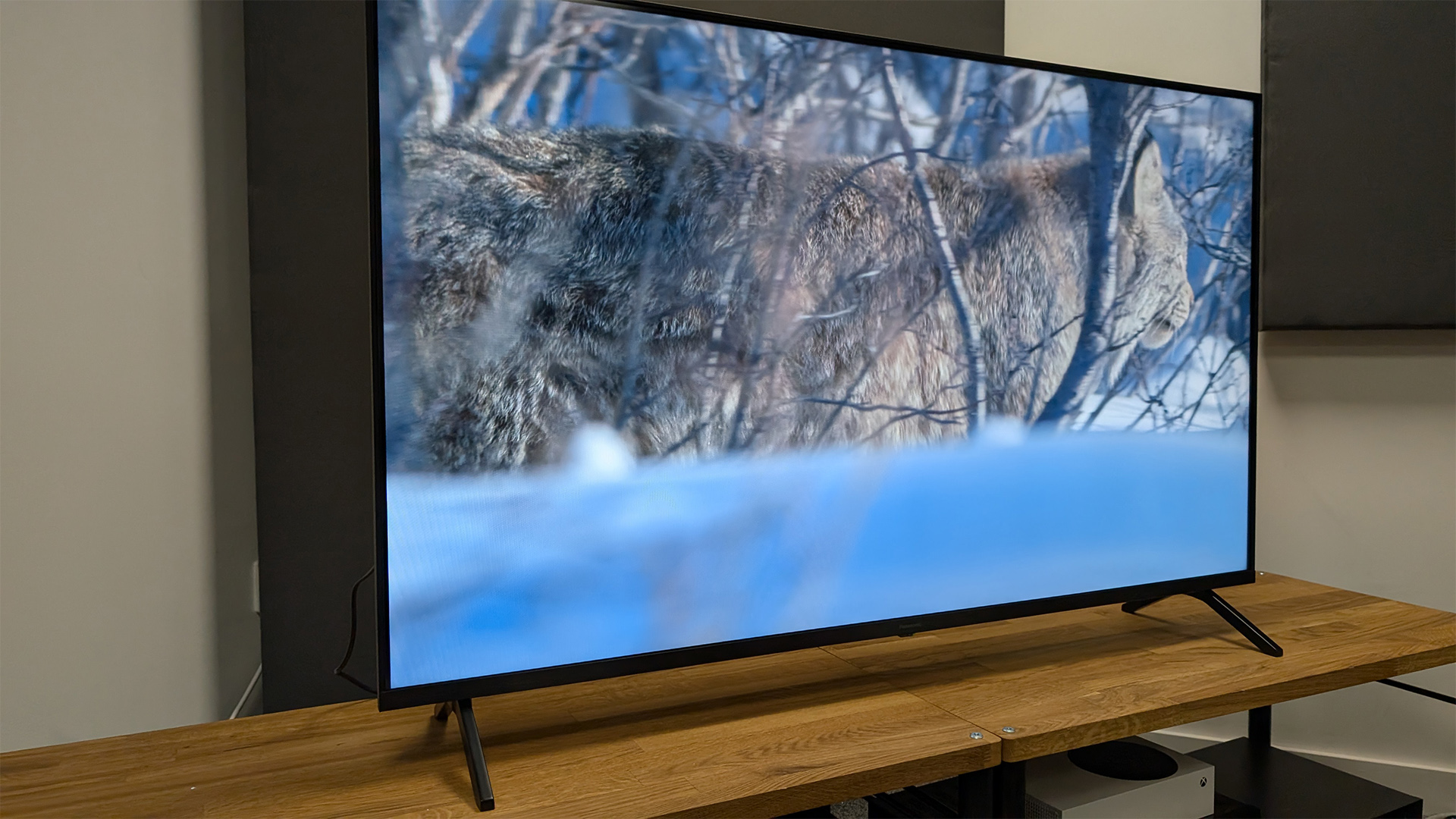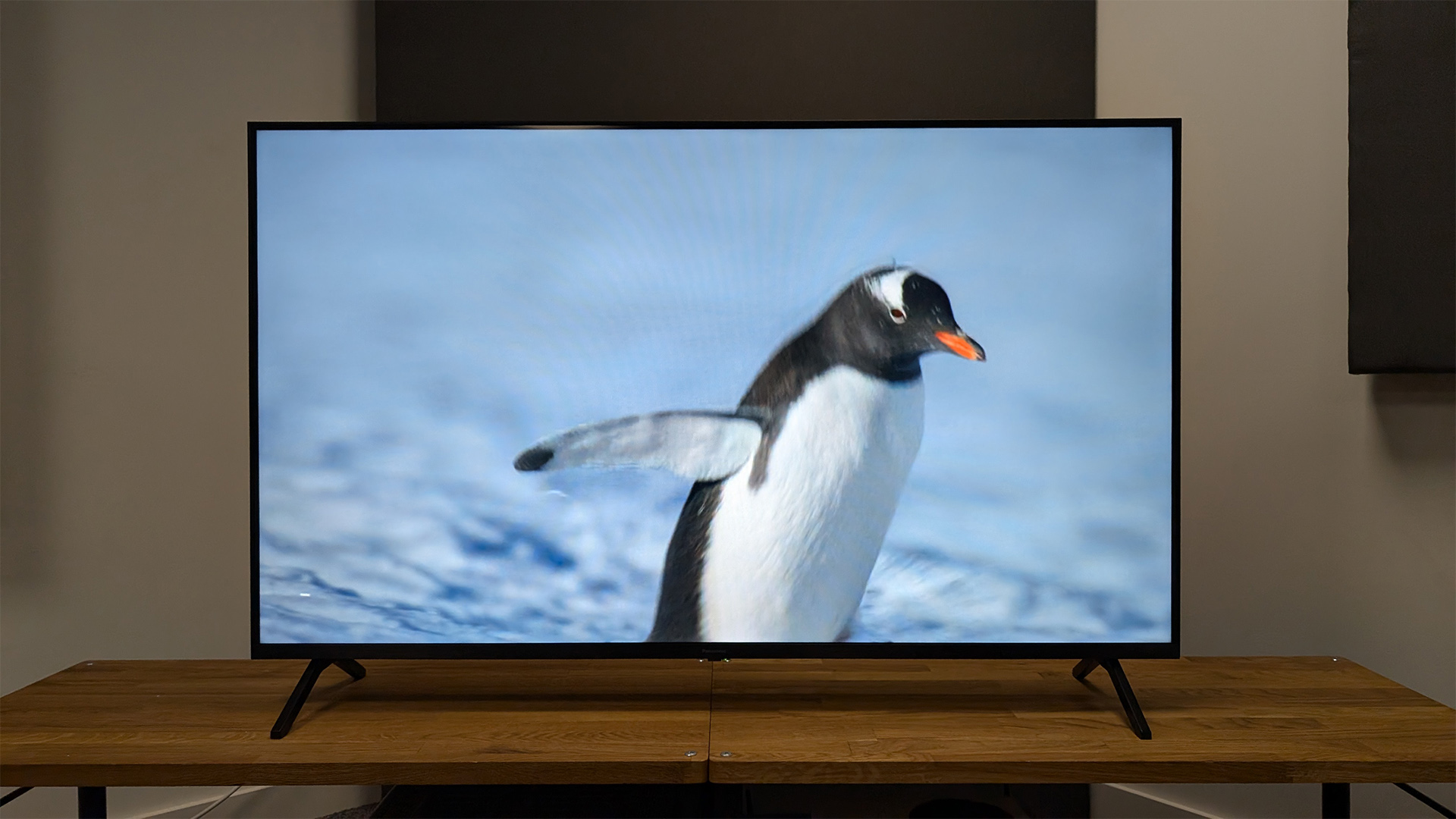
The Panasonic W90A is the top standard LED TV currently offered by the Japanese home cinema giant. While it may not have fancy technologies such as Mini LED backlighting or the giant Technics-tuned speaker-bar seen on Panasonic's flagship sets, it’s still a very interesting TV for a couple of reasons.
First, it’s one of the first TVs from Panasonic to run Amazon’s Fire TV software rather than the firm’s own My Home Screen system, which in recent years has rather been left behind by its rivals in terms of design and app availability. Second, it retains the brand’s iconic focus on delivering 'as the director intended' picture quality – a key area where many affordable TVs fail. But with rivals from Hisense, TCL and Amazon’s own Omni QLED range nipping at its heels, can the W90A succeed in this very busy segment of the market?
Price

The 55-inch version of the W90A we have in for testing was priced at £1199 when it launched, but it has been discounted very heavily since then and can currently be bought for just £699.
That price puts the W90A in direct competition with numerous mid-range sets, including the 55-inch version of the Amazon Fire TV Omni QLED, which is currently available for £519, and the five-star Samsung Q80D, which is available for £699.
It also puts the TV in spitting distance of numerous Mini LED rivals, including the 55-inch TCL Q9BK, which currently retails for £800 in the UK.
Sadly, unlike the Panasonic Z95A OLED we tested and gave five stars to earlier this year, the W90A isn’t being sold outside Europe, so you can’t currently get it in the US or Australia.
Design

As far as TVs go, the Panasonic W90A is an unassuming unit. It features small bezels, no obvious speaker grilles on its front and a basic, plastic chassis; if you removed its branding most buyers would probably struggle to know who built it.
Assembly is easy, with the TV coming with two feet that are attached using four included screws. The only minor quibble here is that there is only one attachment configuration, and that forces you to place the feet at the widest ends of the TV.

Screen size 55 inches (also available in 43, 50, and 65 inches)
Type LED
Backlight Full Array Local Dimming LED
Resolution 4K
HDR formats HLG, Dolby Vision, HDR10, HDR10+
Operating system Fire OS
HDMI inputs x 4 (2 x 48Gbps HDMI 2.1)
Gaming features 4K/144Hz, 4K/120Hz, VRR, ALLM
ARC/eARC eARC
Optical output? Yes
Dimensions (hwd, without stand) 72 x 123 x 8.4 cm
This is fine if you have a large TV stand, but annoying if it’s on the smaller side – as was the case in our test room, where the wide gap between the two feet meant it didn’t fit onto our regular test rack. In an ideal world, we would like the option to mount the feet towards the centre of the TV’s bottom edge (as you can with models such as the Sony Bravia 8) or have a pedestal stand, as its direct rival the Samsung Q80D does.
Otherwise, the set feels well made, and practical – it has all its side-facing ports tucked far enough in to let you attach cables without them being permanently visible, peeking around the side of the set, for instance.
The remote control is identical to that bundled with the Z95A – a utilitarian, grey plastic unit with shortcuts to all the apps, services and settings menus you need. The only downside is that, once again, it hasn't got a backlight, which makes using it in the dark awkward.
Features

The W90A features the same HCX Pro AI Processor MK II chip as its more expensive sibling, the Panasonic Z95A. This means it has the same AI powers and focus on enhancing key picture performance metrics, including colour accuracy as well as detail and motion clarity in low light settings.
As is customary with Panasonic TVs, the W90A supports all of the four current TV HDR formats – HLG, HDR10, HDR10+ and Dolby Vision. Dolby Vision IQ and HDR10+ Adaptive are on board, too, which means the TV will adapt content in the Dolby Vision and HDR10+ formats to the brightness and colour temperature of the light in the room. The goal here is to preserve contrast, colour accuracy, and bright and dark detail.

The W90A offers a competitive set of features for gamers with a PS5, Xbox Series X/S or PC. Highlights included 4K/144Hz maximum refresh rate for those with a PC rig powerful enough, VRR and ALLM, and Dolby Vision Gaming HDR. It’s also fast enough to let current-generation consoles, which cap at 120Hz, run at full speed.
The only minor downside for gamers is that, like its more expensive sibling, the W90A has only two HDMI 2.1 ports that can run 4K/120Hz (or 144Hz), and one of those doubles as the set’s eARC. This eARC port will almost certainly be required if you decide to partner the TV with a soundbar or other sound system, in which case you will be left with just one top-spec HDMI socket. That won't be a problem for everyone, but hardcore gamers with multiple machines will find it a source of frustration.
The bigger issue that TV and movie aficionados will likely baulk at, however, is its use of a standard FALD (Full Array Local Dimming) LED backlight rather than one featuring Mini LEDs. Both technologies aim to improve key picture metrics such as black level and general light control by splitting the LEDs into gridded zones that can be lit independently of one another, but Mini LED uses much smaller LEDs that are placed in significantly denser arrangements, giving it – on paper – more dimming zones and more granular control over the backlight. The denser LED arrangements can also help raise maximum and peak brightness levels.
But, as we know, having tested TVs since well before the panel war focused on plasma vs LCD, having more-advanced hardware doesn’t always lead to better picture quality. A big factor is always how the maker tunes and optimises the panel. Which leads us to the most important question of this review – how does it perform when watching movies?
Picture

Having put the W90A directly up against Mini LED rivals in our viewing rooms, the answer to the above question is nuanced, but positive overall.
Starting with the W90A’s strengths, it's clear from the moment we take it out of the box and power up our first test disc, a 4K Blu-ray of Blade Runner 2049, that Panasonic has stuck to its focus on delivering a balanced, authentic picture.
In the Standard picture preset to which the TV defaults, motion handling is undeniably heavy-handed and the picture looks a little overblown, though nowhere near the level of many rival sets, including the Amazon Omni Fire QLED. But, like all recent Panasonic TVs we have reviewed, including the Z95A OLED, many of the issues are quickly fixed – or at least mitigated – by switching to the Filmmaker Mode preset.
Once that is done, the picture reveals Panasonic’s greatest strength – its approach to colour and skin tones. As Officer K flies into the dystopian, dusty protein farm in Blade Runner 2049, the warm palette reveals oodles of detail, with details of dust flakes across tarps and a hollow tree being clearly visible. As he moves into the farmhouse, the TV continues to impress. Dave Bautista’s face has a wonderfully three-dimensional look as the warmth and wide hue between the lightest and darkest parts of his face create a true sense of depth, keeping him distinct even against the scene’s dark, near-black background. This is helped by decent backlight uniformity and stability, which ensure there are no annoying flickers or abnormalities distracting from the scene.
The added colour volume is even more apparent after a fight scene, where the W90A adds a wide range of reds to K’s face as he tries to catch his breath. This leads to a more immersive picture than most FALD sets are capable of. During our comparisons, the W90A even makes some of the cheaper Mini LED sets, including the TCL 855K, look slightly flat and pale, demonstrating the care Panasonic has put into making the most of the cheaper panel tech.

The same remains true as we switch to our Dune: Part 2 4K Blu-yay. The added insight that the W90A’s stellar colour reproduction brings makes every detail of the Fremen warriors stand out. Light control is also good, with the sparkling sand holding lustre, but with plenty of richness and warmth – impressive considering the lack of Quantum Dots.
However, with any rapid fluctuations between light and dark, some issues creep in. The black costumes of the Harkonnen soldiers fighting the Fremen occasionally lose detail, with entire segments looking black, making one warrior in particular look like he’s fighting a shadow.
Moving to our 4K Blu-ray copy of It, the issue becomes more pronounced. As Georgie creeps into the basement, the Panasonic W90A falls victim to a standard issue we experience on many LCD sets – black crush. Segments of the scene come up as flat black, losing subtle but important details that are retained on the Mini LED sets we pit it against. This isn’t helped by the fact that the blacks on offer do have a slightly grey tone, showing the W90A can’t match many of the mid-range Mini LEDs we have tested this year for black depth.
Moving to our 4K Blu-ray of Pan – a terrible movie, but a disc we use to check peak brightness performance due to its atypically high 4000 nits mastering – the W90A slightly struggles. The TV is bright, but as we watch a flying pirate ship sail directly into a bright sunset, the panel struggles to separate the incredibly bright core of the sun from the blue skyline, leading to a lack of contrast and solidity.
Sound

The W90A comes with a basic audio set-up that pairs two 10W speakers in stereo. Powering up Top Gun: Maverick, the lack of a woofer means the usually thumping bassline in Kenny Loggins' iconic Danger Zone lacks weight, and there’s a general thinness to the audio.
The pattern repeats during the opening of Oppenheimer, where the swelling, explosive drum track introducing the film sounds soft and generally not powerful enough to communicate the intended menacing, explosive feel.
However, it is far from the worst you’ll find. Playing Blade Runner 2049’s bassy second scene, Panasonic avoids the common pitfall of trying to push the speakers beyond what they are capable of, and while the warbling, booming low-end scream of the scene’s music lacks weight, the Panasonic never distorts.
Though all the sound comes from the centre of the TV, dialogue is also separated enough from the noise for you to hear what’s going on, even if the overall quality of the sound isn’t as immersive as you would get from a moderately capable soundbar.
Verdict

The Panasonic W90A is a competent LCD TV that retains the brand’s focus on accuracy and naturalness. Though it can’t match the peak brightness or shadow detail of competing Mini LED sets that are only moderately more expensive, this focus at least lets it compete in other areas we care about – chief of which is colour accuracy. If you’re a serious movie fan who values this factor, the W90A is a solid choice.
SCORES
- Picture 4
- Sound 3
- Features 5
MORE:
Read our review of the Amazon Fire TV Omni QLED
Also consider the Samsung Q80D
Read our TCL 845K review
Best TVs: flagship OLEDs and affordable flatscreens tried and tested







